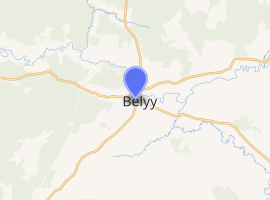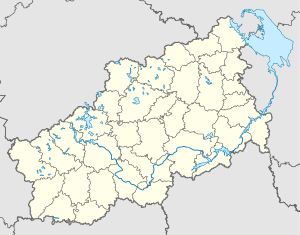Bely, Tver Oblast
Bely (Russian: Бе́лый) is a town and the administrative center of Belsky District in Tver Oblast, Russia, located on the Obsha River. Population: 3,772 (2010 Census);[3] 4,350 (2002 Census);[10] 5,228 (1989 Census);[11] 6,900 (1897).
Bely Белый | |
|---|---|
Town[1] | |
.jpg) In Bely | |
.png) Coat of arms | |
Location of Bely 
| |
 Bely Location of Bely  Bely Bely (Tver Oblast) | |
| Coordinates: 55°50′N 32°57′E | |
| Country | Russia |
| Federal subject | Tver Oblast[1] |
| Administrative district | Belsky District[2] |
| Urban settlement | Bely[2] |
| First mentioned | 1359 |
| Elevation | 185 m (607 ft) |
| Population | |
| • Total | 3,772 |
| • Estimate (2018)[4] | 3,197 (-15.2%) |
| • Capital of | Belsky District[5], Bely Urban Settlement[2] |
| • Municipal district | Belsky Municipal District[6] |
| • Urban settlement | Bely Urban Settlement[6] |
| • Capital of | Belsky Municipal District[7], Bely Urban Settlement[6] |
| Time zone | UTC+3 (MSK |
| Postal code(s)[9] | 172530 |
| OKTMO ID | 28606101001 |
History
The name of the town means "white" in Russian, although it is unknown how or why this name originated. The fortress of Bely is first mentioned in a chronicle in 1350, since it was conquered by the Grand Duchy of Lithuania. It was located on the border between Lithuanian and Russian lands, and intermittently changed affiliation between Lithuania (later Poland) and the Grand Duchy of Moscow.[12] In the 15th century, it became the seat of the Belsky branch of the ruling House of Gediminas. The town was overrun by the Grand Duchy of Moscow in 1503. Three years later, Muscovites built a formidable castle, which the Lithuanians laid a siege to in 1508. The town was again subordinated to the Polish–Lithuanian Commonwealth between 1618 and 1654, after which it finally went under Moscow.
In the course of the administrative reform carried out in 1708 by Peter the Great, Bely became the center of Belsky Uyezd of Smolensk Governorate and remained there until 1929, with the exception of the brief periods between 1713 and 1726, when it belonged to Riga Governorate, and between 1775 and 1796, when Smolensk Governorate was transformed into Smolensk Viceroyalty.
On 12 July 1929, governorates and uyezds were abolished, and Belsky District with the administrative center in the Bely was established. It belonged to Rzhev Okrug of Western Oblast.[13][14] On August 1, 1930 the okrugs were abolished, and the districts were subordinated directly to the oblast. On 29 January 1935 Kalinin Oblast was established, and Belsky District was transferred to Kalinin Oblast.[13][15] During World War II, in 1941—1943, the district was occupied by German troops, and Bely was severely damaged. On August 22, 1944, the district was transferred to newly established Velikiye Luki Oblast. On October 2, 1957, Velikiye Luki Oblast was abolished, and Belsky District was transferred back to Kalinin Oblast. On February 13, 1963 the district was abolished and merged into Nelidovsky District; on November 3, 1965 it was re-established.[15] In 1990, Kalinin Oblast was renamed Tver Oblast.[14]
Administrative and municipal status
Within the framework of administrative divisions, Bely serves as the administrative center of Belsky District.[5] As an administrative division, it is incorporated within Belsky District as Bely Urban Settlement.[2] As a municipal division, this administrative unit also has urban settlement status and is a part of Belsky Municipal District.[6]
Economy
Industry
There are enterprises of timber and food industries located in Bely.[16]
Transportation
A paved road connecting Nelidovo and Smolensk via Dukhovshchina passes Bely. There are local roads. The closest railway stations are in Nelidovo (on the railway connecting Moscow and Riga via Velikiye Luki) and Vladimirsky Tupik (the terminus of a railway which branches off in Safonovo from the line connecting Moscow and Smolensk.
Culture and recreation
.jpg)
Bely contains five cultural heritage monuments of federal significance and additionally sixty-five objects classified as cultural and historical heritage of local significance. The federally protected monuments are archeological sites related to the old town of Bely.[17]
There is a local museum in Bely, founded in 1925.[18]
References
Notes
- Law #34-ZO
- Law #34-ZO stipulates that the borders of the settlements (administrative-territorial divisions) are identical to the borders of the urban and rural settlements (municipal divisions), and that the borders of the administrative districts are identical to the borders of the municipal districts. Law #19-ZO, which describes the borders and the composition of the municipal formations in Belsky Municipal District, lists the town of Bely as a part and the administrative center of Bely Urban Settlement of that district.
- Russian Federal State Statistics Service (2011). "Всероссийская перепись населения 2010 года. Том 1" [2010 All-Russian Population Census, vol. 1]. Всероссийская перепись населения 2010 года [2010 All-Russia Population Census] (in Russian). Federal State Statistics Service.
- "26. Численность постоянного населения Российской Федерации по муниципальным образованиям на 1 января 2018 года". Federal State Statistics Service. Retrieved January 23, 2019.
- Государственный комитет Российской Федерации по статистике. Комитет Российской Федерации по стандартизации, метрологии и сертификации. №ОК 019-95 1 января 1997 г. «Общероссийский классификатор объектов административно-территориального деления. Код 28 206», в ред. изменения №278/2015 от 1 января 2016 г.. (State Statistics Committee of the Russian Federation. Committee of the Russian Federation on Standardization, Metrology, and Certification. #OK 019-95 January 1, 1997 Russian Classification of Objects of Administrative Division (OKATO). Code 28 206, as amended by the Amendment #278/2015 of January 1, 2016. ).
- Law #19-ZO
- Law #4-ZO
- "Об исчислении времени". Официальный интернет-портал правовой информации (in Russian). June 3, 2011. Retrieved January 19, 2019.
- Почта России. Информационно-вычислительный центр ОАСУ РПО. (Russian Post). Поиск объектов почтовой связи (Postal Objects Search) (in Russian)
- Russian Federal State Statistics Service (May 21, 2004). "Численность населения России, субъектов Российской Федерации в составе федеральных округов, районов, городских поселений, сельских населённых пунктов – районных центров и сельских населённых пунктов с населением 3 тысячи и более человек" [Population of Russia, Its Federal Districts, Federal Subjects, Districts, Urban Localities, Rural Localities—Administrative Centers, and Rural Localities with Population of Over 3,000] (XLS). Всероссийская перепись населения 2002 года [All-Russia Population Census of 2002] (in Russian).
- "Всесоюзная перепись населения 1989 г. Численность наличного населения союзных и автономных республик, автономных областей и округов, краёв, областей, районов, городских поселений и сёл-райцентров" [All Union Population Census of 1989: Present Population of Union and Autonomous Republics, Autonomous Oblasts and Okrugs, Krais, Oblasts, Districts, Urban Settlements, and Villages Serving as District Administrative Centers]. Всесоюзная перепись населения 1989 года [All-Union Population Census of 1989] (in Russian). Институт демографии Национального исследовательского университета: Высшая школа экономики [Institute of Demography at the National Research University: Higher School of Economics]. 1989 – via Demoscope Weekly.
- Историческая справка (in Russian). Belsky District Administration. Retrieved July 21, 2015.
- Воробьёв, М. В. (1993). Г. В. Туфанова (ed.). Административно-территориальное деление Смоленской области (in Russian). Государственный архив Смоленской области. pp. 118–133.
- Малыгин, П. Д.; Смирнов, С. Н. (2007). История административно-территориального деления Тверской Области (PDF). Tver. pp. 14–15. OCLC 540329541.
- Справка об изменениях в административно-территориальном делении Тверской губернии - Калининской области (in Russian). Архивы России. Archived from the original on April 19, 2012. Retrieved March 1, 2014.
- Экономика (in Russian). Belsky District official website. Retrieved July 11, 2015.
- Памятники истории и культуры народов Российской Федерации (in Russian). Russian Ministry of Culture. Retrieved June 2, 2016.
- Бельский краеведческий музей (in Russian). Российская сеть культурного наследия. Archived from the original on May 16, 2015. Retrieved July 21, 2015.
Sources
- Законодательное Собрание Тверской области. Закон №34-ЗО от 17 апреля 2006 г. «Об административно-территориальном устройстве Тверской области», в ред. Закона №66-ЗО от 1 октября 2014 г. «О внесении изменения в статью 18 Закона Тверской области "Об административно-территориальном устройстве Тверской области"». Вступил в силу со дня официального опубликования. Опубликован: "Тверские ведомости", №17 (специальный выпуск), 19 апреля 2006 г. (Legislative Assembly of Tver Oblast. Law #34-ZO of April 17, 2006 On the Administrative-Territorial Structure of Tver Oblast, as amended by the Law #66-ZO of October 1, 2014 On Amending Article 18 of the Law of Tver Oblast "On the Administrative-Territorial Structure of Tver Oblast". Effective as of the official publication date.).
- Законодательное Собрание Тверской области. Закон №19-ЗО от 28 февраля 2005 г. «Об установлении границ муниципальных образований, входящих в состав территории муниципального образования Тверской области "Бельский район", и наделении их статусом городского, сельского поселения», в ред. Закона №56-ЗО от 13 июля 2009 г «О внесении изменений в Приложение №1к Закону Тверской области "Об установлении границ муниципальных образований, входящих в состав территории муниципального образования Тверской области "Бельский район", и наделении их статусом городского, сельского поселения"». Вступил в силу со дня официального опубликования. Опубликован: "Тверские ведомости", №10, 11–17 марта 2005 г. (Legislative Assembly of Tver Oblast. Law #19-ZO of February 28, 2005 On Establishing the Borders of the Municipal Formations Comprised by the Territory of the Municipal Formation of "Belsky District" and on Granting Them the Status of Urban and Rural Settlements, as amended by the Law #56-ZO of July 13, 2009 On Amending Appendix 1 of the Law of Tver Oblast "On Establishing the Borders of the Municipal Formations Comprised by the Territory of the Municipal Formation of "Belsky District" and on Granting Them the Status of Urban and Rural Settlements". Effective as of the day of the official publication.).
- Законодательное Собрание Тверской области. Закон №4-ЗО от 18 января 2005 г. «Об установлении границ муниципальных образований Тверской области и наделении их статусом городских округов, муниципальных районов», в ред. Закона №65-ЗО от 24 июля 2012 г. «О внесении изменения в статью 2 Закона Тверской области "Об установлении границ муниципальных образований Тверской области и наделении их статусом городских округов, муниципальных районов"». Вступил в силу через десять дней после официального опубликования. Опубликован: "Тверские ведомости", №3, 21–27 января 2005 г. (Legislative Assembly of Tver Oblast. Law #4-ZO of January 18, 2005 On Establishing the Borders of the Municipal Formations of Tver Oblast and on Granting Them the Status of Urban Okrugs, Municipal Districts, as amended by the Law #65-ZO of July 24, 2012 On Amending Article 2 of the Law of Tver Oblast "On Establishing the Borders of the Municipal Formations of Tver Oblast and on Granting Them the Status of Urban Okrugs, Municipal Districts". Effective as of the day which is ten days after the official publication.).